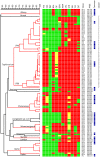An association of genotypes and antimicrobial resistance patterns among Salmonella isolates from pigs and humans in Taiwan
- PMID: 24760078
- PMCID: PMC3997404
- DOI: 10.1371/journal.pone.0095772
An association of genotypes and antimicrobial resistance patterns among Salmonella isolates from pigs and humans in Taiwan
Abstract
We collected 110 Salmonella enterica isolates from sick pigs and determined their serotypes, genotypes using pulsed-field gel electrophoresis (PFGE), and antimicrobial susceptibility to 12 antimicrobials and compared the data with a collection of 18,280 isolates obtained from humans. The pig isolates fell into 12 common serovars for human salmonellosis in Taiwan; S. Typhimurium, S. Choleraesuis, S. Derby, S. Livingstone, and S. Schwarzengrund were the 5 most common serovars and accounted for a total of 84% of the collection. Of the 110 isolates, 106 (96%) were multidrug resistant (MDR) and 48 (44%) had PFGE patterns found in human isolates. S. Typhimurium, S. Choleraesuis, and S. Schwarzengrund were among the most highly resistant serovars. The majority of the 3 serovars were resistant to 8-11 of the tested antimicrobials. The isolates from pigs and humans sharing a common PFGE pattern displayed identical or very similar resistance patterns and Salmonella strains that caused severe infection in pigs were also capable of causing infections in humans. The results indicate that pigs are one of the major reservoirs to human salmonellosis in Taiwan. Almost all of the pig isolates were MDR, which highlights the necessity of strictly regulating the use of antimicrobials in the agriculture sector in Taiwan.
Conflict of interest statement
Figures

References
-
- Majowicz SE, Musto J, Scallan E, Angulo FJ, Kirk M, et al. (2010) The global burden of nontyphoidal Salmonella gastroenteritis. Clin Infect Dis 50: 882–889. - PubMed
Publication types
MeSH terms
Substances
LinkOut - more resources
Full Text Sources
Other Literature Sources

